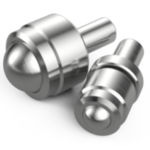

Precision matters, especially when it comes to hardness testing. At the heart of every hardness test lies the indenter: a small, often diamond-tipped specialized tool used to create an indentation on a material’s surface. This component plays an essential role in the accuracy and consistency of your results.
Whether you’re testing metals, ceramics or coatings, using the right indenter is essential for achieving reliable measurements and complying with international standards. GNEHM supplies high-quality hardness test indenters for all major hardness testing methods, including Vickers, Knoop, Brinell and Rockwell.
A hardness test indenter is the part of a hardness tester that physically deforms the surface of a test specimen under a specified load. The size, shape and depth of the resulting indentation are used to calculate the material’s hardness value.
The indenter must:
The choice of indenter impacts not only the accuracy of the measurement, but also its compliance with testing standards such as ISO 6507 (Vickers), ISO 6508 (Rockwell), and ASTM E10 (Brinell).

Hardness test indenters function in four steps:
Each of these steps relies on the quality, geometry and material of the indenter.
GNEHM offers a full range of hardness indenter types for all major test methods:
For low-load Vickers and Knoop testing we offer microhardness indenters with extremely fine tip tolerances. Used for microelectronics, coatings and surface layers.

The performance and durability of an indenter are directly linked to its material. GNEHM offers indenters made from:
All indenters conform to applicable international standards such as:
Choosing the right indenter is critical to obtaining reliable, repeatable hardness results and maintaining compliance with international standards. Its shape, size and material must match the test method, load range and material properties to ensure accurate measurements and full standardization.
The right indenter depends on your:
For example:
Need assistance? Our experts can help you determine the best solution for your application, including compatibility with both GNEHM and third-party testers.
Whether you need a standard Vickers indenter or a custom Knoop tip for microhardness testing, GNEHM delivers Swiss-engineered quality you can trust.
GNEHM indenters are:
Whether you’re testing high-strength alloys or delicate coatings, GNEHM offers a full range of standard and custom indenters to suit your needs. Request a quote or contact our team for specifications, pricing and expert support.
Vickers indenters have a symmetrical diamond pyramid shape; Knoop indenters have an elongated pyramid shape, better suited for thin layers and microstructures.
Diamond is the hardest known material, making it ideal for creating precise, repeatable indentations on a wide range of materials.
No, each test method requires a specific indenter geometry and material. Using the wrong type invalidates the results.
Yes, our indenters are designed to fit a wide range of machines from other manufacturers. Contact us for cross-compatibility info.
With proper care and usage, diamond indenters can last thousands of tests. Regular inspection is recommended.